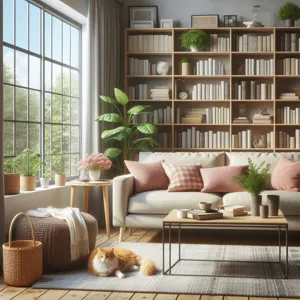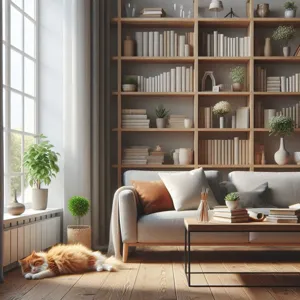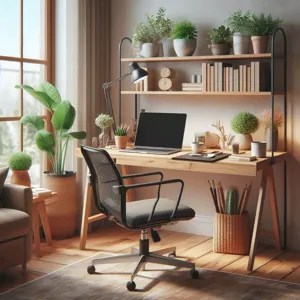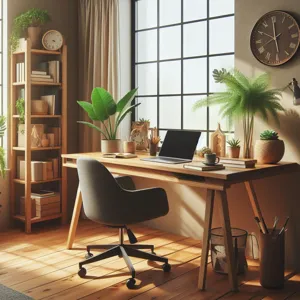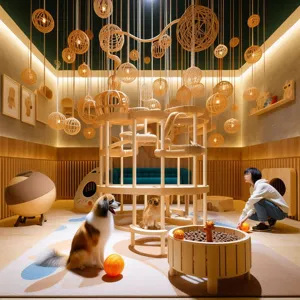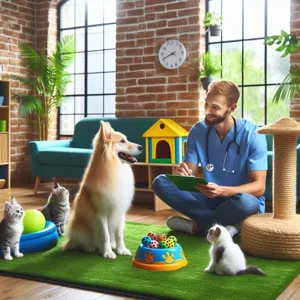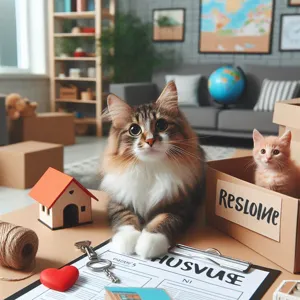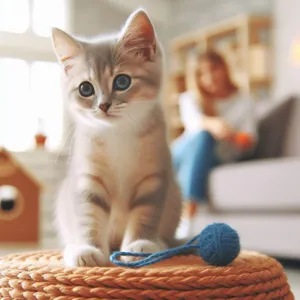As the warm weather rolls in and the doors and windows fly open to invite fresh air, the last thing you want is for unwanted pests to turn your home into their personal playground.
From pesky ants marching through your kitchen to stealthy rodents scurrying in the shadows, these uninvited guests can disrupt your peace and compromise your living space. Safeguarding your home from pests is not just about maintaining a clean environment; it’s about protecting your health, property, and overall well-being. In this comprehensive guide, we’ll explore the top strategies to fortify your home against infestations, equipping you with practical tips and proactive measures. Whether you’re a seasoned homeowner or a first-time renter, our expert advice will help you create a pest-free sanctuary that you can truly relax in. Say goodbye to the anxiety of unexpected visitors and hello to a more secure and comfortable home!
1. Understanding Common Household Pests

Understanding common household pests is the first crucial step in safeguarding your home from unwanted intruders. Many homeowners may not realize that pests can vary significantly in their behavior, habitats, and the risks they pose. In this section, we will delve into some of the most prevalent culprits that could be lurking in your living spaces.
**Ants** are among the most common household pests, often invading kitchens in search of food. These tiny foragers can form extensive colonies, and once they find a reliable food source, they can quickly become a major nuisance. Identifying the type of ant present can help determine the best course of action for removal and prevention.
**Cockroaches** are another formidable foe. Not only are they unsightly, but they can also pose health risks by spreading diseases. They thrive in warm, humid environments and are notorious for their ability to hide in the smallest crevices. Keeping your home clean and dry is essential in preventing their entry.
**Rodents**, including mice and rats, can cause significant damage to your property and pose serious health risks. These pests are adept at finding their way into homes, often through small gaps and holes. To combat them, it’s vital to seal entry points and maintain a tidy living space, as clutter can provide perfect nesting areas.
**Termites** are the silent destroyers of the pest world. Often undetected until significant damage has occurred, these wood-eating insects can compromise the structural integrity of your home. Regular inspections and preventive treatments can help protect your property from their relentless appetite.
**Spiders**, while often beneficial in controlling other pest populations, can be unsettling for many homeowners. Some species can be venomous, so understanding which types are common in your area can help you decide whether to remove them or leave them be.
By familiarizing yourself with these common household pests, you can take proactive measures to deter them from invading your home. The next step will be identifying effective strategies to prevent these uninvited guests from making themselves at home. Armed with knowledge, you’ll be better equipped to create a pest-free environment and protect your living space from unwanted visitors.
2. Conducting a Thorough Home Inspection
A thorough home inspection is a cornerstone of effective pest management and is the first line of defense against unwanted invaders. By meticulously examining your home, you can identify potential entry points, nesting areas, and signs of existing infestations. Start from the outside and work your way in. Look for cracks and gaps in the foundation, windows, and doors; even the smallest openings can serve as gateways for pests like ants, spiders, and rodents. Pay special attention to areas where utility lines enter your home, as these can often be overlooked.
As you circle your property, inspect your landscaping and yard. Overgrown vegetation, piles of leaves, or standing water can attract pests by providing shelter and breeding grounds. Trim back shrubs and trees that are too close to your home, and ensure that gutters are clean and functioning properly to prevent moisture buildup.
Once you’ve completed the exterior inspection, turn your attention to the interior. Check attics, basements, and crawl spaces for any signs of pest activity, such as droppings, chewed materials, or nesting debris. Don’t forget to look behind appliances and in hidden corners, as these areas can easily become overlooked hotspots for pest activity.
Document your findings and create a plan of action based on what you discover. Whether it’s sealing entry points, removing potential food sources, or considering professional pest control services, being proactive after a thorough inspection can significantly reduce the likelihood of pests making your home their own. Regularly scheduled inspections—ideally every season—will help maintain a pest-free environment and give you peace of mind knowing your home is safeguarded against unwanted visitors.
3. Sealing Entry Points: Where Pests Enter

When it comes to pest control, the first line of defense is often the most overlooked: sealing entry points. Unwanted pests, from ants and spiders to rodents and termites, are always on the lookout for a cozy refuge, and your home can unwittingly provide an ideal habitat. To safeguard your sanctuary, it’s essential to identify and seal the various entryways that these unwelcome guests use to infiltrate your living space.
Begin your inspection at the foundation of your home. Look for cracks in the walls, gaps around windows, and spaces where pipes or wires enter the structure. Even the smallest openings can be an invitation for pests. Use caulk or expanding foam to fill in these gaps, ensuring a tight seal that prevents critters from sneaking in. Don’t forget about doors; installing weather stripping can keep out not only cold drafts but also pesky insects.
Pay special attention to your garage and attic, as these are common entry points for rodents and larger pests. Install screens on vents and ensure that any openings to the outside are tightly sealed. If you have a chimney, consider a chimney cap to keep birds and other wildlife from making a nest in your home.
Additionally, examine your landscaping for potential access points. Trees and shrubs should be trimmed away from the house, as branches can act as bridges for pests. Mulch should be kept at least six inches away from the foundation to deter termites and other insects.
By proactively sealing entry points, you not only fortify your home against pests but also create a more comfortable living environment. Taking these steps ensures that your home remains a safe haven, free from the disturbances of unwanted intruders.
4. Maintaining a Clean and Clutter-Free Environment
One of the most effective strategies to safeguard your home from unwanted pests is to maintain a clean and clutter-free environment. Pests are notorious for seeking out places that provide food, shelter, and warmth, and a disorganized home can inadvertently serve as an open invitation.
Start by focusing on the kitchen, where crumbs and spills can become a feast for ants, roaches, and other unwanted guests. Regularly wipe down countertops, sweep the floors, and promptly store food in airtight containers. Don’t forget to check behind appliances like the fridge and stove, as these hidden corners can accumulate crumbs and grease, creating a perfect breeding ground for pests.
Next, turn your attention to other areas of the house. Declutter rooms, closets, and storage spaces to eliminate potential hiding spots. Piles of clothes, boxes, and other items can provide cozy nests for rodents and insects. By keeping surfaces clear and items neatly organized, you not only create a more aesthetically pleasing living space but also deter pests from taking up residence.
Outside, maintaining a tidy yard is equally crucial. Trim back overgrown vegetation, remove debris, and ensure that garbage bins are sealed tightly. Standing water, such as in clogged gutters or bird baths, can attract mosquitoes, so be sure to regularly empty and clean these areas.
Finally, consider implementing a regular cleaning schedule that includes deep cleaning tasks, such as vacuuming carpets, dusting surfaces, and cleaning out the garage or attic. By committing to a clean and clutter-free environment, you’re not just enhancing your home’s visual appeal—you’re also significantly reducing the chances of a pest invasion. Remember, a well-kept home is your first line of defense against unwanted pests, so make cleanliness a priority!
5. Proper Food Storage and Waste Management

Proper food storage and waste management are foundational strategies in keeping unwanted pests at bay. In a household, the kitchen is often the first area where pests make their unwanted entrance, drawn in by the tantalizing scents of food and the promise of easy meals. It’s crucial to establish a routine that not only protects your food but also minimizes the potential for infestations.
Begin with airtight containers for your dry goods. Glass or high-quality plastic containers with secure lids are ideal for keeping flour, sugar, cereals, and snacks safe from curious critters. Not only do these containers prevent pests from accessing your food, but they also help maintain freshness and flavor. Consider labeling each container with the date of purchase to ensure you use older items first, reducing waste and keeping your pantry organized.
In addition to securing your food, pay close attention to leftovers and perishables. Store them in sealed containers and promptly refrigerate any items after meals. This practice not only discourages pests but also helps prevent food spoilage.
On the waste management side, ensure that your garbage bins are tightly sealed and emptied regularly. Consider using bins with locking lids to deter rodents and insects from gaining access. Composting can also attract unwanted visitors if not done correctly. Make sure your compost bin is well-aerated and covered to keep pests at bay and encourage healthy decomposition.
Lastly, don’t forget about the areas around your home. Regularly check for spills or crumbs under appliances and furniture, as these can serve as an open invitation to pests. By implementing these food storage and waste management strategies, you’ll create an environment that is less appealing to unwanted guests, paving the way for a healthier, pest-free home.
6. Managing Outdoor Spaces: Landscaping Tips
Managing outdoor spaces effectively is an essential strategy in safeguarding your home from unwanted pests. The way you design and maintain your landscaping can significantly influence the presence of critters in and around your property. Start by carefully selecting plants that are naturally resistant to pests. For instance, lavender and marigolds not only add beauty to your garden but also act as natural repellents against various insects.
Next, consider the layout of your vegetation. Dense shrubbery and overgrown plants can provide ideal hiding spots for pests. Keep plants well-trimmed and maintain a clear zone around the foundation of your home. This not only discourages pests from nesting close to your house but also creates a barrier that makes it harder for them to access entry points.
Another important aspect is the management of mulch and soil. While mulch is beneficial for retaining moisture and regulating soil temperature, it can also attract termites and other pests if applied too thickly. Aim for a mulch layer of no more than three inches, and consider using cedar or rubber mulch, which are less appealing to pests. Additionally, keep firewood stored away from the home and elevated off the ground; this will prevent termites from finding a cozy place to thrive.
Finally, ensure proper drainage in your outdoor spaces to avoid standing water, which can attract mosquitoes and other water-loving pests. Regularly check for clogged gutters and downspouts, and make sure there are no areas where water can pool. By implementing these landscaping tips, you can create an outdoor environment that not only enhances the beauty of your home but also discourages pests from making it their own. With a little attention to detail, your outdoor spaces can become a fortress against unwanted invaders.
7. Utilizing Natural Remedies for Pest Control

When it comes to safeguarding your home from unwanted pests, sometimes the best solutions are those that come straight from nature. Utilizing natural remedies for pest control not only helps you maintain a pest-free environment but also ensures that your home remains safe for children and pets. These eco-friendly alternatives can be effective, affordable, and often easy to prepare.
One of the most popular natural pest deterrents is essential oils. Scents like peppermint, lavender, and tea tree oil are known to repel various insects. For instance, a simple mixture of water and a few drops of peppermint oil can be sprayed around entry points to keep spiders and ants at bay. Not only does this method effectively deter pests, but it also fills your home with a delightful fragrance.
Another powerful natural remedy is diatomaceous earth, a fine powder made from the fossilized remains of tiny aquatic organisms. This non-toxic substance works by dehydrating insects when they come into contact with it. Sprinkling diatomaceous earth around areas where pests are likely to enter, such as doorways and windowsills, can create a formidable barrier against ants, roaches, and even fleas.
For those grappling with a rodent problem, consider using a mix of cayenne pepper, garlic, and water to create a potent spray. Rodents are highly sensitive to strong smells, and this concoction can help keep them at bay. Simply spray it around your home’s perimeter and entry points for a natural deterrent that won’t harm your furry friends.
Lastly, planting pest-repelling plants in your garden can be a twofold strategy. Marigolds, basil, and rosemary not only enhance your garden’s aesthetic appeal but also act as natural repellents for common pests like aphids and mosquitoes. Incorporating these plants into your landscaping can create a more inviting environment while simultaneously providing a defensive barrier.
By embracing these natural remedies for pest control, you can effectively protect your home while promoting a healthier living space for your family. With a little creativity and some knowledge of nature’s bounty, you can keep pesky intruders at bay without relying on harsh chemicals.
8. The Role of Professional Pest Control Services
When it comes to safeguarding your home from unwanted pests, enlisting the expertise of professional pest control services can be a game-changer. While there are many DIY methods available, nothing compares to the comprehensive assessment and targeted treatments provided by trained professionals.
These experts bring a wealth of knowledge, understanding the behavior and biology of various pests that invade homes, from insidious termites to pesky rodents. With their keen insight, they can identify vulnerabilities in your home that you may not have even considered—such as hidden entry points, damp areas prone to infestations, or potential food sources that attract unwelcome guests.
One of the primary benefits of hiring a professional pest control service is their ability to implement a customized pest management plan tailored to your specific needs. They utilize a range of advanced techniques and eco-friendly products that not only eliminate existing pests but also create a barrier to prevent future infestations. This proactive approach ensures that your home remains a safe haven, free from the disruptions and health risks associated with pests.
Additionally, professional services often provide ongoing monitoring and maintenance, giving you peace of mind that your home is consistently protected. With scheduled visits, they can quickly address any signs of re-infestation and adjust their strategies as necessary, saving you time, effort, and potentially costly damages down the line.
In summary, while DIY solutions can be effective for minor issues, when it comes to safeguarding your home from persistent or severe pest problems, professional pest control services offer the expertise, tailored strategies, and ongoing support necessary to ensure your home remains a pest-free sanctuary. Investing in these services is not just about removing pests; it’s about protecting your home and your family’s well-being in the long run.
9. Implementing Regular Maintenance Checks
Implementing regular maintenance checks is a crucial strategy in the ongoing battle against unwanted pests. Think of your home as a fortress. Just as a castle requires periodic inspections to identify weaknesses in its defenses, your home needs the same level of attention to keep pests at bay.
Start by scheduling routine inspections of both the interior and exterior of your home. During these checks, look for signs of pest activity, such as droppings, gnaw marks, or nests. Pay special attention to areas that are often overlooked, like basements, attics, and crawl spaces, where pests love to hide.
Next, examine your home’s structure for potential entry points. Cracks in the foundation, gaps around windows and doors, and holes in screens can all serve as gateways for pests seeking refuge. Seal any openings with caulk or weather stripping to create a barrier that prevents unwanted intruders from making themselves at home.
Don’t forget to inspect your landscaping, as well. Overgrown plants can provide cover for pests, while piles of leaves and debris can serve as breeding grounds. Regularly trim back shrubs, remove clutter, and maintain a clean yard to deter pests from encroaching on your space.
Finally, consider creating a seasonal maintenance checklist. With the changing of seasons, different pests become more active. By being proactive and adjusting your checks accordingly—such as clearing gutters in the fall to prevent mosquito breeding or inspecting for termites in the spring—you’ll stay one step ahead and safeguard your home effectively.
By implementing regular maintenance checks, not only do you fortify your home against pests, but you also promote a healthier living environment for you and your family. A little diligence goes a long way in ensuring that your sanctuary remains pest-free, allowing you to enjoy your home to the fullest.
10. Educating Your Family About Pest Prevention
Educating your family about pest prevention is one of the most effective strategies to safeguard your home from unwanted intruders. Pest control isn’t solely the responsibility of pest management professionals; it begins at home, within your family unit. By instilling knowledge and encouraging proactive habits, you can create a formidable barrier against pests.
Start by involving everyone in the discussion about common household pests—ants, cockroaches, rodents, and termites. Share information about how these pests can infiltrate your living space, what attracts them, and the potential health risks they pose. Understanding the enemy is the first step in prevention.
Next, implement a few simple yet powerful practices that your family can adopt. Teach them to regularly check for any cracks or gaps around doors and windows, emphasizing the importance of sealing these entry points. Discuss the significance of proper food storage—keeping pantry items in airtight containers and promptly cleaning up spills and crumbs—to eliminate food sources for pests. Encourage everyone to maintain cleanliness in common areas, including regular trash disposal and the immediate clean-up of pet waste, which can attract unwanted visitors.
Moreover, make it a family activity to inspect the yard and garden for potential pest habitats. Clearing away debris, keeping outdoor spaces tidy, and ensuring plants are healthy and well-maintained can minimize the risk of infestations.
By fostering a culture of awareness and responsibility, you empower your family to take an active role in pest prevention. This knowledge not only protects your home but also promotes a sense of teamwork and pride in maintaining a comfortable and safe living environment. Remember, when everyone is informed and engaged, you significantly bolster your defenses against unwanted pests.
11. Seasonal Strategies for Pest Control
When it comes to pest control, a proactive approach tailored to the changing seasons can make all the difference in safeguarding your home from unwanted intruders. Each season brings its own set of pest challenges, and understanding these patterns is key to effectively managing them before they become a nuisance.
**Spring** is the time when many pests emerge from their winter slumber. As temperatures rise, ants, termites, and mosquitoes are particularly active. This is the perfect moment to inspect your home for any cracks or openings in windows and doors that could serve as entry points. Seal any gaps, and consider applying a barrier treatment around your property to deter these early intruders. Additionally, keep your yard tidy by removing any standing water and debris where pests might breed.
As summer rolls in, the heat can make your home an attractive haven for insects like flies and wasps. To keep them at bay, ensure that food is stored securely and that trash cans are tightly sealed. Regularly cleaning up outdoor spaces and utilizing natural repellents, such as citronella candles or essential oils, can also help maintain a pest-free environment.
With the arrival of **autumn**, rodents start seeking warm shelter as temperatures drop. This is the time to take preventative measures by checking for any signs of rodent activity, such as droppings or gnaw marks. Install traps and create a barrier by storing firewood away from the home and ensuring that all food is properly sealed. This is also a good time to inspect your roof for any potential nesting sites, such as overhanging branches or loose shingles.
Finally, **winter** may seem like a quiet time for pest control, but don’t be fooled. While many pests hibernate, some, like cockroaches and cluster flies, may seek warmth inside your home. Keep your home well-ventilated and refrain from leaving food out. Regularly check for signs of pest activity and consider professional inspections to ensure that your home remains pest-free throughout the colder months.
By implementing these seasonal strategies, you can stay one step ahead of pests, ensuring your home remains a comfortable and safe haven year-round.
12. Recognizing Early Signs of Infestation
When it comes to keeping your home pest-free, vigilance is key. Recognizing the early signs of infestation can save you time, money, and a whole lot of stress down the line. Pests tend to be stealthy creatures, but they often leave behind subtle clues that can signal their unwelcome presence.
Start by paying attention to any unusual sounds—scratching or scurrying noises coming from walls, ceilings, or beneath floors can indicate that rodents are making themselves at home. Additionally, look for signs of droppings, which vary by pest but often appear as small, dark pellets in corners, along baseboards, or near food sources.
Another telltale sign is damaged food packaging or gnawed wood, particularly in areas where you store food or have wooden furniture. If you notice small holes in packaging or bite marks on your pantry staples, it’s time to investigate further.
Don’t overlook visual indicators either. For instance, the presence of discarded wings or shed exoskeletons can hint at an insect infestation, while stains or smear marks around entry points are often signs of rodents.
Lastly, be alert to any unusual odors; a musty smell can suggest a termite problem, while a strong, foul scent may indicate a rat or mouse issue. By familiarizing yourself with these early signs of infestation, you can act quickly to address any pest problems before they escalate, ensuring your home remains a safe and comfortable haven.
13. Eco-Friendly Pest Control Options
When it comes to safeguarding your home from unwanted pests, eco-friendly pest control options offer a sustainable and humane approach to pest management. With growing awareness about the impact of chemical pesticides on the environment and human health, many homeowners are seeking natural alternatives that are both effective and safe.
One popular eco-friendly option is the use of essential oils. Oils such as peppermint, tea tree, and citronella are known for their pest-repelling properties. For instance, a simple mixture of water infused with a few drops of peppermint oil can deter ants and spiders when sprayed around entry points and windowsills. Similarly, citronella is effective against mosquitoes, making it a great natural repellent for outdoor gatherings.
Another effective strategy is the introduction of beneficial insects into your garden. Ladybugs, lacewings, and predatory wasps are natural predators of common garden pests like aphids and caterpillars. By encouraging these insects into your yard, you create a balanced ecosystem that minimizes pest populations without resorting to harmful chemicals.
Diatomaceous earth is another fantastic eco-friendly option that acts as a mechanical pesticide. This natural powder, made from the fossilized remains of tiny aquatic organisms, can be sprinkled in areas where pests are likely to roam. Its abrasive nature damages the exoskeletons of insects, effectively dehydrating and eliminating them while remaining safe for humans and pets.
For those dealing with rodent issues, humane traps can be a great solution. These traps allow you to catch rodents alive and release them far from your home, preventing the use of toxic poisons that can pose risks to pets and children.
By opting for these eco-friendly pest control options, not only do you safeguard your home from unwanted invaders, but you also contribute to a healthier environment. Embracing these natural methods fosters a sense of responsibility toward our planet while keeping your living space free from pests.
14. Building a Pest-Resistant Home
Building a pest-resistant home is a proactive approach that can save you time, money, and a whole lot of hassle in the long run. It begins with thoughtful design and construction choices that prioritize prevention. Start by assessing your property and identifying potential entry points. This includes gaps around windows and doors, cracks in the foundation, and any spaces where pipes enter the home. Sealing these openings with durable materials like caulk or foam can significantly reduce the chances of pests finding their way inside.
Choosing the right building materials also plays a crucial role in pest resistance. Opt for treated wood that is less susceptible to termites and rot, and consider materials that are chemically resistant to insect infestations. For instance, concrete and metal are excellent choices for foundations and structural elements, as they deter pests that thrive on organic materials.
Landscaping is another vital component of building a pest-resistant home. Keep shrubs and trees trimmed back from the exterior walls, as overhanging branches can provide a direct route for pests. Additionally, create a buffer zone of gravel or mulch around the foundation; this not only enhances drainage but makes it harder for pests to travel to your home.
Finally, consider integrating pest-resistant features such as screens on windows and doors, and installing door sweeps to create a tight seal. These small yet effective measures can enhance your home’s defenses against unwanted intruders. By building a pest-resistant home, you’re not just creating a barrier against pests; you’re investing in the long-term comfort and safety of your living environment. Embrace these strategies to ensure that your sanctuary remains a pest-free haven for years to come.
15. Conclusion: A Proactive Approach to Pest Management
In conclusion, adopting a proactive approach to pest management is the cornerstone of a pest-free home. It’s not merely a matter of reacting to infestations when they arise; rather, it’s about implementing consistent preventive measures that deter pests from making your home their own. By understanding the behaviors and habits of common pests, you can create an environment that is less inviting to unwelcome guests.
Start by maintaining a clean and clutter-free space. Regularly inspecting your home for potential entry points and sealing gaps can significantly reduce the likelihood of pests slipping inside unnoticed. Incorporating natural deterrents like essential oils or planting pest-repellent herbs in your garden not only enhances your home’s ambiance but also serves as an effective barrier against many common nuisances.
Additionally, keeping your outdoor spaces tidy—trimming overgrown vegetation, managing standing water, and ensuring proper drainage—can prevent pests from thriving in your yard. Remember, regular maintenance is key; scheduling seasonal check-ups with pest control professionals can provide an extra layer of security and peace of mind.
Ultimately, a proactive approach is about vigilance and education. Equip yourself with knowledge about the pests that are common in your area and stay informed about the best practices for prevention. By fostering a habit of awareness and taking preventive action, you can safeguard your home from unwanted pests, ensuring a comfortable and harmonious living environment for you and your family.
In conclusion, safeguarding your home from unwanted pests requires a proactive and informed approach. By implementing the top strategies outlined in this blog post, from sealing entry points to maintaining a clean environment, you can significantly reduce the risk of infestations. Remember, prevention is always easier and more effective than dealing with a pest problem after it arises. Stay vigilant, conduct regular inspections, and don’t hesitate to seek professional help when necessary. Your home should be a sanctuary, free from the worry of pests, and with these strategies, you can enjoy peace of mind knowing you’re taking the right steps to protect your living space. Thank you for reading, and here’s to a pest-free home!










